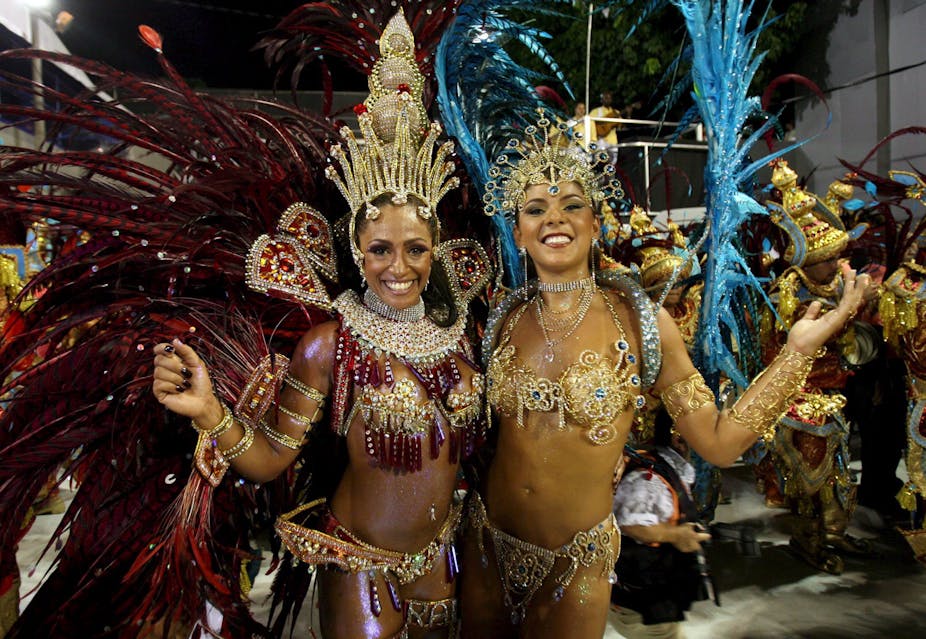All eyes are on Brazil and its vibrant culture, with the FIFA World Cup now into its third week and Rio de Janeiro set to host the 2016 Olympic Games. But while football is arguably Brazil’s most popular sport, its national rhythm is samba.
When she walks she’s like a samba
That swings so cool and sways so gentle
That when she passes, each one she passes
Goes “Ahhhhh”– The Girl from Ipanema, Stan Getz and João Gilberto, 1964
Samba is a genre that encompasses a vast array of dance and music styles with complex lineage. In dance terms, samba includes everything from partnered dance styles performed in a cozy embrace, through to the individually-danced intricate footwork and rapid hip movement of the dancers in the annual Rio Carnaval.

Samba’s origins lie in the dances and religious practices of the West African slaves that were brought to Brazil during Portuguese colonisation, the slave trade beginning in approximately 1532.
As famous dancer Jaime Arôxa explains in his 1996 Samba de Gafieira video, early samba, developed mainly in the northeast region of Brazil, was danced individually in a circle or line to percussion and clapping. When samba spread south to urban centres in the late 19th century, other forms of the dance started to emerge.
First, there is the samba of the carnaval parades. The samba in this context is danced individually as a part of a very large group, and is performed to complex percussion music played by a large marching band. Carnaval is, as London-based arts author Ian Driver writes:
partly a modern manifestation of medieval Christian festivals that marked the coming of Lent with subversive and anti-authoritarian festivities and partly a descendant of the African coronation traditions.
Originally, African-Brazilian people used the Christian event as a way to practice government-repressed aspects of their culture including their dance and music. The original carnaval groups (cordões and blocos) first appeared in approximately 1917 in Rio de Janeiro, and the first government-sanctioned, and re-named, escola de samba (samba school – a collective of dancers and musicians) was founded in 1928.

In the 1930s and 40s carnaval samba was harnessed for nationalist political purposes under Getúlio Vargas’ rule, promoting celebration of the African heritage in Brazil’s mixed-race culture.
The Rio de Janeiro samba schools now participate in annual competitions in a purpose-built venue which was first used in 1984. The sambadrome is a road-like structure flanked by seating on both sides, with a capacity of 90,000 people. While the celebrations in Rio de Janeiro are perhaps the most well-known outside of Brazil, carnaval is celebrated all over Brazil, usually in February.
In terms of the music, samba involves a syncopation which creates a feeling of suspension, and this, as described by American cultural critic Barbara Browning:
leaves the body with a hunger that can only be satisfied by filling the silence with motion.
As can be seen below, while the dancers Brenda Carvalho and Anderson Mendez da Rocha do not step on count four, the hips continue to move and therefore fill that count.
The following is one version of the footwork for samba no pé, which is samba danced individually. There are many versions of the footwork. Here it is shown with a back accent, and not travelling. The hips drop on the side of the working foot, which is achieved by relaxing the corresponding knee.
In the 1930s another kind of samba emerged in Rio de Janeiro and became a popular social dance in the 1940s – samba de gafieira, often referred to as simply samba. This partnered dance, that took place in a type of dance hall called a gafieira, was danced to new urbanised samba music styles that utilised non-percussion instruments such as the guitar and flute.
Samba de gafieira bears some resemblance to tango in terms of how the dancers’ legs entwine but it is less serious and more playful and cheeky in demeanour.
Above is an example of a modern style of samba de gafieira dance, called funkeado because of the funk influence in the movement and in the music typically used. This is, of course, performance work. Social dancing, in contrast, is not choreographed and typically contains less acrobatic elements.
It was at the end of 1938 at the opening day of the 1939 New York World’s Fair, that samba de gafieira was first performed outside of Brazil.

In the 1940s and early 1950s partnered samba was a popular social dance in America and Europe (including England), but it was a highly modified Westernised ballroom version of samba that people were learning, and not samba de gafieira.
Certain Hollywood films of the period such as That Night in Rio (1941) and The Gang’s All Here (1943) were important in popularising ballroom samba as they depicted Rio de Janeiro or featured Portuguese-born Brazilian dancer, actress, and singer Carmen Miranda.
The styles of samba described above, as well as others, are still practised today, both in Brazil and internationally. Long may they continue!
Are you an academic or researcher in the field of dance and/ or social history? If there’s a dance tradition you’d like to write about for this series contact the Arts + Culture editor.

